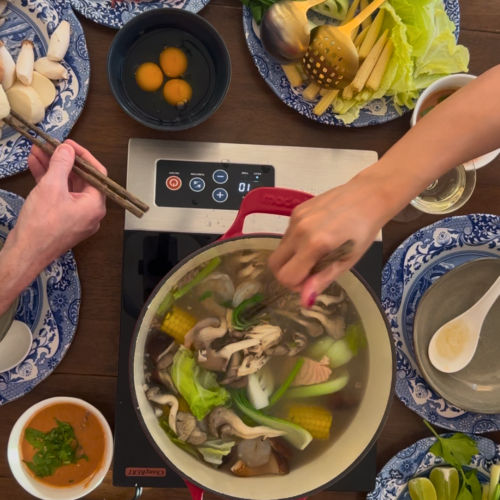
Hot Pot Party
Ingredients
- Hot pot is about variety so prepare bite-sized ingredients in advance. Here’s a simple shopping list:
Proteins (1–2 options):
- Thinly sliced beef or pork pre-sliced options are available in most Asian markets.
- Shrimp, fish fillets, calamar or tofu firm or silken.
- Optional splurges: Wagyu beef slices or Alaskan king crab legs.
Vegetables (3–4 options):
- Leafy greens: Spinach bok choy napa cabbage.
- Mushrooms: Enoki shiitake or button.
- Root vegetables: Carrots, radish, taro
- Sweet additions: Sweet corn or baby corn.
Carbs (1–2 options):
- Noodles: Udon egg noodles or rice vermicelli.
- Dumplings or rice cakes.
Extras (Optional):
- Fish balls, meatballs, or lotus root slices.
- Choose ingredients that bring you joy and cater to your guests’ preferences!
Instructions
Plan for the Essentials
Guest Count:
- For 4–6 people, plan one pot for every 2–3 guests. If you have a larger group, consider using two pots for variety.
Equipment Setup:
- Place your induction burner or portable gas stove at the center of the table.
- Use a cast iron pan, wok, Dutch oven, or electric pan—anything that distributes heat evenly and keeps the broth simmering.
- Ensure there’s enough space for ingredient platters, dipping sauces, and individual bowls.
Utensils:
- Provide each pot with a soup ladle and a strainer. Individual strainer baskets for guests are a great addition if available.
Start with the Broth
- The broth is the heart of the hot pot, and starting with flavorful options ensures a great base for cooking.
Broth Options:
- Mild Broth: Chicken or vegetable stock with garlic, ginger, and scallions.
- Spicy Broth: Add chili oil, dried chilies, Sichuan peppercorns, and soy sauce to a basic stock.
Pro Tips:
- If your pot doesn’t have a divider, stick to one broth type.
- Keep the broth simmering before transferring it to the table to maintain the right temperature for cooking.
Keep the Dipping Sauces Simple
- Each household has its own sauce traditions. Offer a simple sauce station where guests can customize their flavors:
Basic Sauce Options:
- Soy sauce
- Ponzu (a light, citrusy soy sauce)
- Chili oil
- Minced garlic, ginger, and cilantro as add-ons.
Personal Favorites:
- As a Thai host, I love serving "Nam Jim Suki," a Thai-style sauce made with fermented tofu, pickled garlic, fresh garlic, Thai chili, lime juice, and sesame oil.
Cooking and Eating: The Hot Pot Experience
Cooking Times:
- Meat: 1–2 minutes
- Seafood: 2–3 minutes
- Vegetables: 3–5 minutes
Tips for Guests:
- Stir the broth occasionally to prevent sticking.
- Encourage group cooking for a fun, communal experience.
Table Setup:
- Set a plate with a small bowl, spoon, and chopsticks for each guest.
- If possible, provide individual mini strainers or have a few for sharing.
Drinks and Dessert
- Drinks: Pair with tea, soda, beer, or even champagne for special occasions.
- Dessert: Finish with simple, refreshing options like fresh fruit (melon or oranges) or ice cream.
Video
Notes
Final Tips for Success
- Arrange ingredients on large platters or individual small salad plates to make them look grand and inviting. Presentation matters—you feast with your eyes first!
- Keep extra broth handy for refills and maintain a steady simmer.
- If someone’s new to hot pot, guide them through the process of cooking and pairing sauces.